- What is IoT?
- Industry Wise Most Popular IoT Applications
- List of some top categories of IoT apps
- Essential Requirements for IoT App Development
- IoT App Development Process
- Mobile vs. Web IoT Apps: Which would suit you the best?
- Benefits of Custom IoT Applications
- How to Choose the Right Company for Custom IoT App Development Services
- Perks of Choosing Idea Usher as your favorite IoT App Development Company
- IoT App Development Technology Stack
- Conclusion
- FAQs
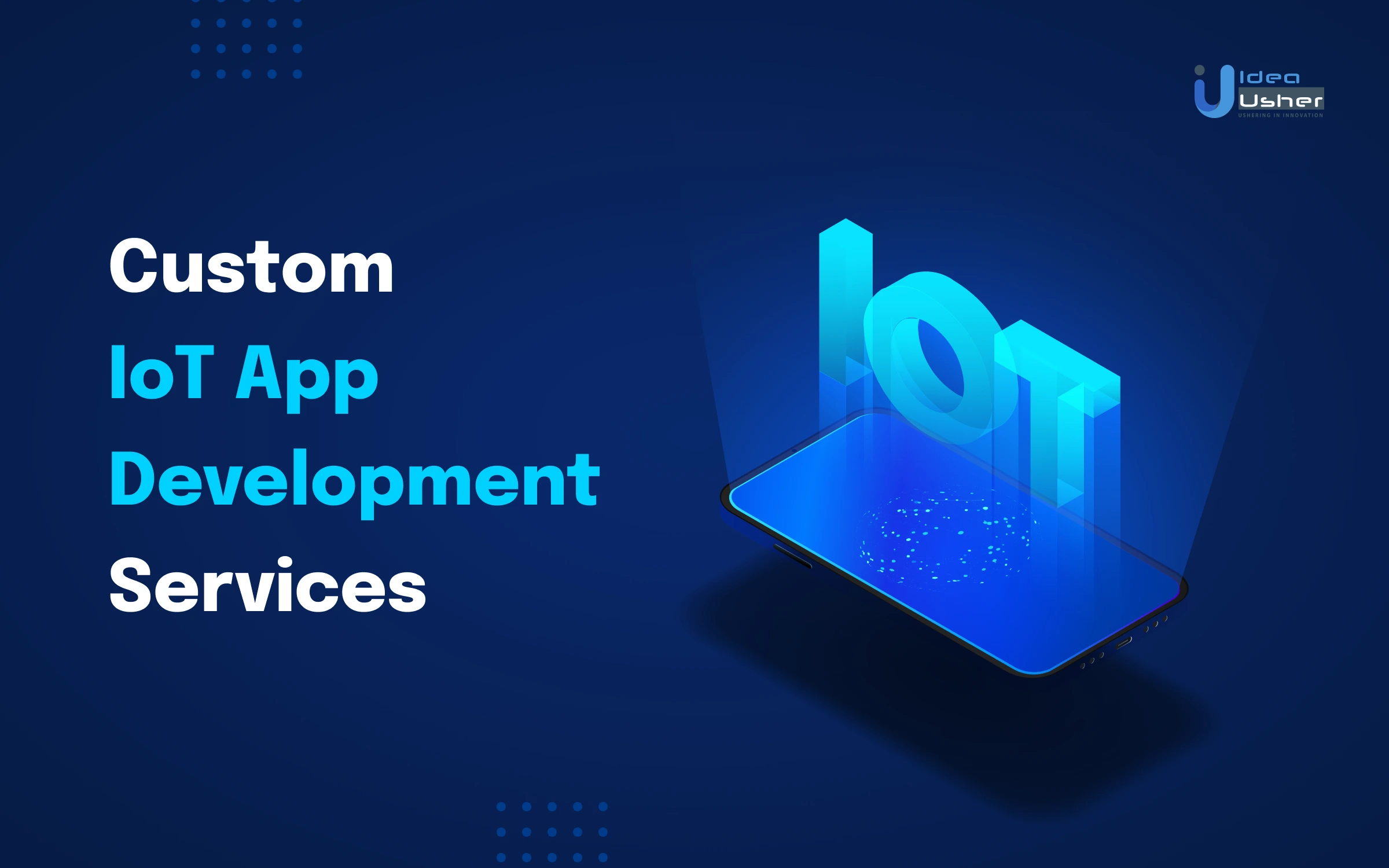
The birth of the Internet of Things (IoT) is rooted in the development of radio frequency identification (RFID) technology and the invention of the internet in the mid-1990s. This invention allowed for the possibility of connecting physical objects to the web and harnessing the power of connected devices. In the 2000s, these early ideas began to gain traction, thanks to the development of wireless technologies and the proliferation of small, low-power embedded devices. This allowed everyday objects like appliances, cars, and even clothing to connect to the internet.
The emergence of the IoT became a reality in the 2010s, as advances in wireless technologies and cloud computing enabled companies to create large-scale, interconnected networks of smart devices. This allowed for the development of smart cities, as well as the growth of smart homes and connected healthcare offerings. Today, the IoT is revolutionizing the way we interact with the world and improving people’s lives everywhere. From connected cars to smart homes to connected healthcare, the possibilities of the IoT are virtually limitless.
- What is IoT?
- Industry Wise Most Popular IoT Applications
- List of some top categories of IoT apps
- Essential Requirements for IoT App Development
- IoT App Development Process
- Mobile vs. Web IoT Apps: Which would suit you the best?
- Benefits of Custom IoT Applications
- How to Choose the Right Company for Custom IoT App Development Services
- Perks of Choosing Idea Usher as your favorite IoT App Development Company
- IoT App Development Technology Stack
- Conclusion
- FAQs
What is IoT?
Internet of Things (IoT) is a revolutionary concept changing how we interact with the world around us. IoT is an interconnected network of physical objects – such as sensors, electronic appliances, and everyday items – that are embedded with electronics, software, and sensors and are capable of collecting and exchanging data over the Internet. These objects are connected to a wide range of wireless networks and can communicate with one another without needing any human intervention.
At its core, the concept of IoT is to provide an infrastructure that allows for more efficient, secure, and automated communication and control of physical objects and systems. This is achieved through intelligent sensors and actuators, allowing real-time data collection and analysis. This data can then be used to make decisions, automate processes, and provide feedback to users. In addition, IoT networks also use cloud computing, machine learning, and artificial intelligence to provide more powerful and efficient analytics.
The potential of IoT is immense, and it is already being used to improve our lives in many ways. From smart homes to connected cars, IoT is making our lives easier, safer, and more efficient. The possibilities are endless, and the future of IoT is bright.
Industry Wise Most Popular IoT Applications
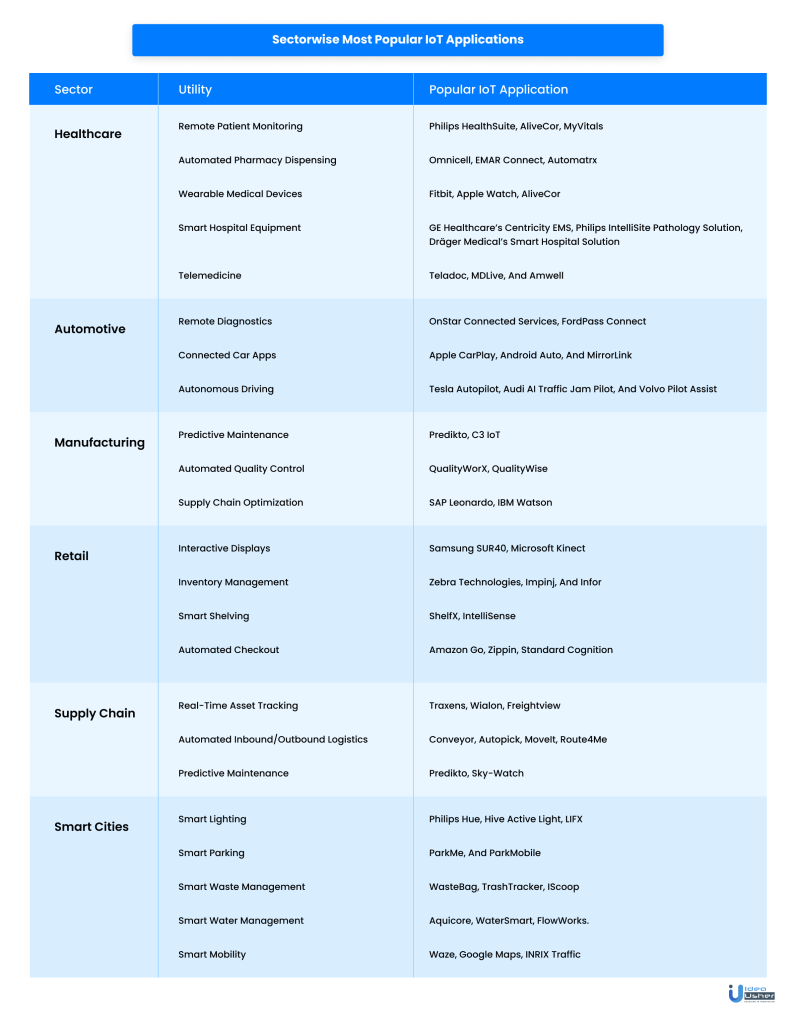
IoT in Healthcare
- Remote Patient Monitoring – Using IoT sensors to track patients’ vital signs and send them to healthcare providers for real-time analysis.
- Automated Pharmacy Dispensing – Using IoT to dispense medications to patients automatically.
- Wearable Devices – Devices integrated with IoT sensors to monitor and display personal health-related info to users.
- Smart Hospital Equipment – IoT-embedded app/platform solutions to monitor, control, and manage hospital medical equipment.
- Telemedicine – Remote doctor diagnostics and patient treatment.
IoT in Automotives
- Remote Diagnostics – Detecting vehicle issues, sending alerts to the driver, and remote diagnostics to detect and fix any issues remotely.
- Connected Car Apps – Mobile device connectivity to access other apps/services, such as navigation and music streaming apps
- Autonomous Driving – IoT-enabled autonomous driving, lane-keeping, adaptive cruise control, and self-parking.
IoT in Manufacturing
- Predictive Maintenance – Using sensor-based data to monitor, detect, and help resolve manufacturing issues and downtimes.
- Automated Quality Control – Using IoT to streamline and improve the quality control process.
- Supply Chain Optimization – Improving supply chain management for better customer experience and increased productivity.
IoT in Retail
- Interactive Displays – Interactive touchscreens that provide customers with product information and reviews.
- Inventory Management – Tracking inventory levels in real-time, enabling rapid restocking of shelves.
- Smart Shelving – Self product level monitoring in real-time and alerting staff about supply necessities.
- Automated Checkout – Allowing quick and hassle-free purchases for customers.
IoT in Supply Chain
- Real-Time Asset Tracking – Monitoring the real-time location and condition of assets, including inventory, shipping containers, and vehicles.
- Automated Inbound/Outbound Logistics – IoT applications can automate inbound (quality inspection, sorting, and storage) and outbound (packing, loading, route optimization, and delivery tracking) logistics processes.
- Predictive Maintenance – Monitoring equipment performance and maintenance prediction.
IoT in Smart Cities
- Smart Lighting – Connected lighting fixtures controlled and monitored by a central system.
- Smart Parking – Using IoT sensor-based analysis to help find available parking spots and reduce traffic congestion.
- Smart Waste Management – Monitoring waste levels and alerting waste management companies
- Smart Water Management – Monitoring water levels, usage, and quality to find leaks, detect contamination, and conserve water
- Smart Mobility – Sensor-based analysis to monitor traffic, inform drivers of traffic conditions, and reduce emissions.
List of some top categories of IoT apps
Home Automation Apps
- Amazon Alexa (smart companion and home automation)
- Downloads: 100 million+, Rating: 4.3 on Playstore, 4.6 on AppStore.
- Google Home (smart companion and home automation)
- Downloads: 100 million+, Rating: 4.3 on Playstore, 4.5 on AppStore
- Nest Home (home safety and utility app)
- Downloads: 100 million+, Rating: 4.1 on Playstore, 4.7 on AppStore
Wearable Device IoT Apps
- Fitbit (fitness, health, and activity tracking)
- Downloads: 50 million+, Rating: 4.2 on Playstore, 4.2 on AppStore
- cult.fit (health, fitness, and gymming companion)
- Downloads: 10 million+, Rating: 4.6 on Playstore, 4.8 on AppStore
- Google Fit (fitness, health, and activity tracking)
- Downloads: 100 million+, Rating: 3.9 on Playstore, 4.4 on AppStore
Smart City/Service Apps
- Google Maps (navigation and GPS-based mapping functionality)
- Downloads: 10 billion+, Rating: 4.1 on Playstore, 4.7 on AppStore
- INRIX ParkMe (car parking)
- Downloads: 0.1 million+, Rating: 3.8 on Playstore, unrated on AppStore
Connected Car Apps
- Android Auto (smart driving assistance and car connectivity)
- Downloads: 1 billion+, Rating: 4.0 on Playstore, not available on AppStore
- AutoMate (navigation, streaming, and dashboard connectivity)
- Downloads: 1 million+, Rating: 3.8 on Playstore, not available on AppStore
Industrial IoT Apps
- Route4Me Route Planner (Logistics route planner)
- Downloads: 0.5 million+, Ratings: 4.3 on Playstore, 4.1 on AppStore
- City Utilities (monthly bill tracking, rebates, and payment convenience)
- Downloads: 0.01 million+, Ratings: 4.2 on Playstore, unrated on AppStore
Essential Requirements for IoT App Development
Cloud technology, dedicated hardware, a reliable network, and intuitive software – are the four primary requirements for any IoT Application Development.
- Cloud technology provides the infrastructure for connecting all the different elements of the Internet of Things (IoT) application. This could include cloud-based storage solutions or a cloud platform for managing the data generated by IoT devices.
- Dedicated hardware are the system’s physical components, such as sensors, gateways, and controllers. They are responsible for collecting and transmitting data from the environment.
- A reliable network is necessary to ensure the data collected from the hardware components is transmitted to the cloud on time. This could be locally based (LAN) or spread widely (WAN) like the Internet.
Finally, intuitive software is required to manage the data collected by the hardware components and display it in a user-friendly way. This could include dashboards, analytics, and visualization tools.
IoT App Development Process
Developing IoT applications is very dynamic; and usually depends on the scale, customizations, and functionalities you seek from the app. Nevertheless, the following five steps can explain most IoT applications’ developmental methodology:
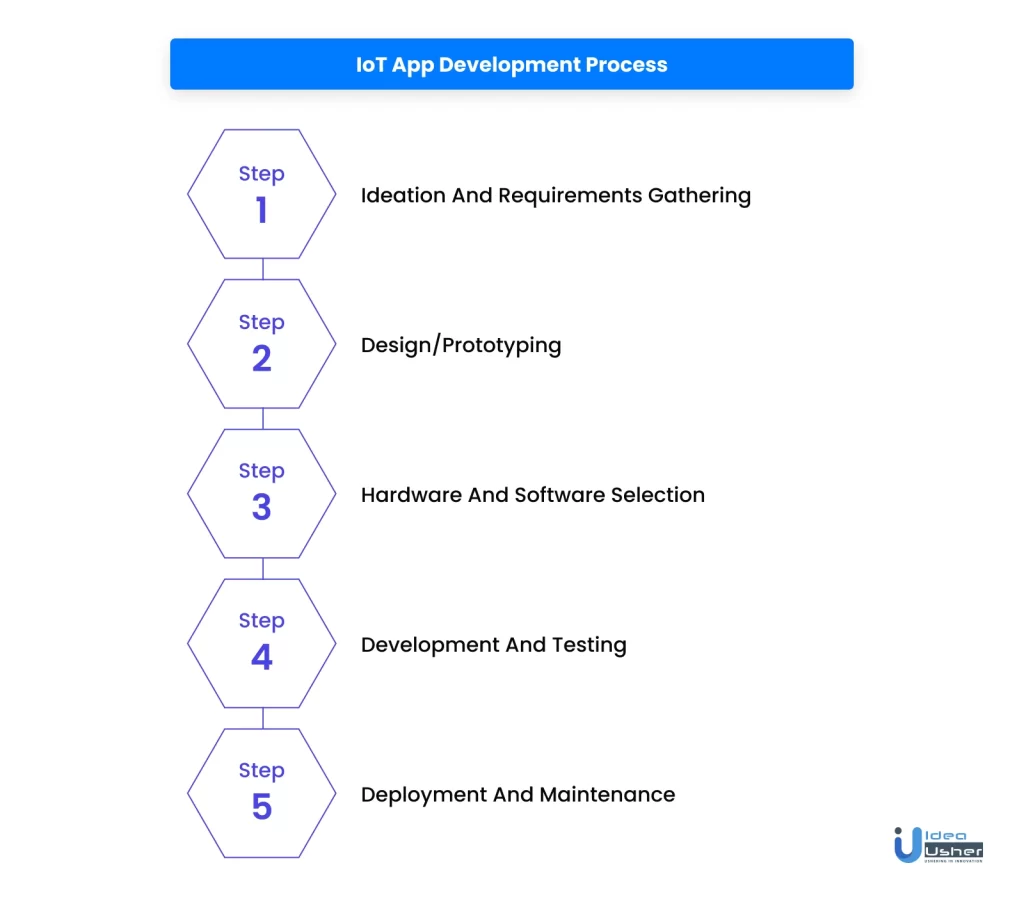
Step 1: Ideation and Requirements Gathering
This is the first step in the development process. It involves brainstorming ideas and collecting requirements specific to the scope and features of the application.
Discuss with your team and stakeholders what you need the app for. Do you want a service app? Perhaps a records keeper? Or an app that tabularizes your daily power consumption?
Think. Rethink. And only then Finalize.
Once finalized, you must acquire the necessary funding, obtain the permits, and secure the required technical and support resources to drive your concept to reality.
Step 2: Design/Prototyping
This is when the application is designed and a prototype is created. The designing phase requires understanding the intricacies of user interface and user experience (UI/UX). A well-thought-out design distinguishes a successful app from one that fails quickly.
Users should be able to easily navigate the app without guessing their way around. Moreover, the flow should be comprehensible and logical, and there should be no broken links or buttons that don’t lead anywhere. Ultimately, the app should feel natural and intuitive to use.
Step 3: Hardware and Software Selection
The next step is to select the proper hardware and software components. Hardware for IoT development usually includes :
- microcontrollers,
- sensors, and
- communication interfaces
Software components include:
- Operating systems (Zephyr, Linux, Android Things, etc.),
- Development platforms (AWS, Google Cloud, Herkou, etc.), and
- Communication protocols (MQTT, CoAP, XMPP, and likewise).
Step 4: Development and Testing
In this step, the prototype app is put to development and testing. Like all other application, website, and software development cycles, this phase is divided into front-end and back-end.
JavaScript is arguably the most widely used language for creating front-end apps. Various frameworks, such as Angular, React, and Vue, leverage the power of JS to make the software development process easier and more enjoyable for developers. Ultimately, the best framework for any project depends on the individual’s experience, preferences, and requirements.
Back-end development requires a more intricate selection of tools, as each component needs to be compatible with the other. If a JavaScript-based front-end layer is desired, then Node.js would be the natural choice for back-end programming as both are JavaScript-based. Preferred JS database options are CrateDB, InfluxDB, MongoDB, RethinkDB, and SQLite; DevOps tools can be Gradie, Jenkins, and Docker.
Once development is complete, the application must be tested (automatedly or manually) to ensure that there are no bugs and that it satisfies the desired user experience requirements.
Step 5: Deployment and Maintenance
Once tested and verified, the app can be deployed to its intended platform (cloud platforms), with ongoing maintenance and support provided. Regular monitoring should be conducted to guarantee that the application remains bug-free and keeps functioning as intended.
Mobile vs. Web IoT Apps: Which would suit you the best?
It all depends on what you’re trying to achieve – do you want a simple app that allows you to connect and perform daily functionalities, or do you want to create something more complex?
If you’re looking for something convenient, Mobile IoT Apps are likely the best choice. They are accessible on the go and allow you to interact with connected devices quickly. Plus, with many of them being built with HTML5, you can create rich, easily updated, and maintain applications.
On the other hand, if you need something more powerful and feature-rich, then Web IoT Apps might be the way to go. With a web-based application platform, you can avail of complex applications with a wide range of features and functionality, such as powerful analytics and data visualization. Plus, you can access these applications from anywhere with an internet connection, making it perfect for those who want to stay connected.
Benefits of Custom IoT Applications
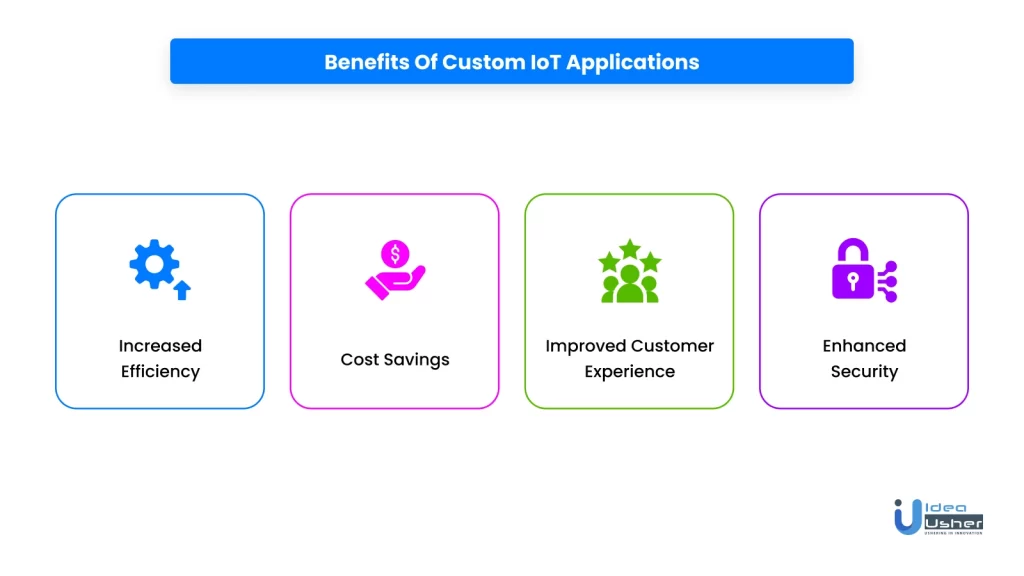
Along with providing enhanced scalability to businesses, customized IoT applications come with many other noteworthy benefits. They can help you and your business through:
1. Increased Efficiency:
Customized IoT applications allow businesses to automate their processes, streamline operations, and access data in real-time. This can significantly reduce the amount of manual labor and time needed for tasks, resulting in improved productivity and efficiency.
2. Cost Savings:
By leveraging IoT technology, businesses can reduce costs associated with labor, energy, and inventory, as well as increase the accuracy and efficiency of their operations. This can lead to significant cost savings and increased profitability.
3. Improved Customer Experience:
IoT applications can help businesses gain valuable insights into customer behavior, allowing them to tailor their services and create a more personalized experience. This can lead to improved customer commitment and satisfaction.
4. Enhanced Security:
Custom IoT applications can be tailored to meet specific security needs, allowing businesses to protect their assets and data from unauthorized access. This can help ensure data integrity and ensure the safety of their customers.
Such facilities can help your business to cater to newer user bases and tap into newer markets for sustenance and growth.
How to Choose the Right Company for Custom IoT App Development Services

With so many options at hand, choosing the perfect company for your app development project can be tricky. But before you finalize, make sure to check on these few aspects:
Experience:
Consider the company’s experience in building custom IoT applications. An experienced team will better understand the technical complexities and nuances of creating a custom IoT application. They should also have the experience necessary to develop an app that meets your specific needs and the ability to guide you through the entire process to ensure your app is successful.
Technology Expertise:
Research the team’s technical expertise. Ensure that the team is experienced in the latest IoT technologies, such as hardware and software integration, cloud computing platforms, embedded systems, etc. The team should also be knowledgeable and experienced in developing custom applications tailored to your specific needs and goals.
Cost:
Cost is also an essential factor to consider. Be aware of the cost of developing the application and ensure that your chosen company offers competitive rates. It is also vital to aspect in the long-term costs related to the maintenance and support of the application and to ensure that the company is transparent and upfront about these costs.
Reputation:
Finally, research the reputation of the app development company you are considering. Reviews and testimonials from past customers can give you a good insight into the quality of their work and the level of customer service they provide. You must also ensure that your chosen company is up-to-date with the latest trends and technologies in the IoT space. This will ensure you get the best possible solution for your custom IoT application.
Perks of Choosing Idea Usher as your favorite IoT App Development Company
At Idea Usher, we recognize the importance of providing businesses and tech enthusiasts with applications that can expand and grow in sync with their evolving requirements. Our team of dedicated experts can not only provide you with the highest quality of services but can also provide you with the most comprehensive suite of value-added benefits. Our developers are highly experienced in creating IoT apps that are both flexible and secure and can adapt to your’ as well as your userbase’s preferences. You can maintain quality for speed and budget with us, and we are always available to guide you with any issues and queries.
IoT App Development Technology Stack
Our competent developers are well-versed in IoT tech stacks for both web2 and web3.
Our Web2 Technology Stack:
- Front-end Technologies: HTML5, CSS3, JavaScript, jQuery, React, Angular, SASS, Bootstrap
- Back-end Technologies: Node.js, PHP, Ruby on Rails, Java, C#, Python
- Databases: MongoDB, MySQL, PostgreSQL, Cassandra, Redis
- Messaging Queue: RabbitMQ
- Cloud Platforms: Amazon Web Services (AWS), Microsoft Azure, Google Cloud Platform
- Container Orchestration: Docker, Kubernetes
- Authentication: OAuth, JWT
- Security: TLS/SSL, Firewall, Anti-Virus
Our Web3 Technology Stack:
- Blockchain Platforms: Ethereum, Hyperledger Fabric, Corda
- Smart Contract Development: Solidity, Hyperledger Composer
- Distributed Storage: IPFS, Storj
- Consensus Protocols: PoW, PoS, PoA, PBFT
- APIs: Web3.js, Ether.js
- Authentication: Wallet-Based Authentication
- Security: TLS/SSL, Firewall, Anti-Virus, Smart Contract based encryption
Conclusion
Developing a custom IoT app can give your business a competitive edge and the ability to stay ahead of the curve. By leveraging the power of the Internet of Things, you can create innovative solutions that can help to increase efficiency, reduce costs, and improve customer satisfaction. And with the right IoT app development partner, your business will reap the benefits of the technology. Lastly, through thoughtful strategizing and implementation, you and your business can capitalize on the potential of the IoT.
Get in touch with us now!
Contact Idea Usher at [email protected]
Or reach out at: (+1)732 962 4560, (+91)859 140 7140
FAQs
Q. What are IoT mobile apps?
A. IoT mobile apps are mobile applications that allow users to manage, control, monitor, and interact with IoT devices and services. They typically allow users to view data from connected devices, control settings, receive notifications, and more. Examples of IoT mobile apps include home security systems, home automation systems, smart home appliances, and smart lighting systems.
Q. What are the benefits of IoT based mobile apps?
A. IoT based mobile apps are beneficial in many ways. They can help to automate processes, improve efficiency, and provide real-time data that can be used to make better decisions. Furthermore, they can provide enhanced security and access control, improved customer service, and convenience.
Q. How much time does it take to develop a customized IoT app?
A. The time required to develop a customized IoT application depends on the complexity of the application and the features required. Generally, creating an IoT application with preferential features and customizations can take anywhere from a few weeks to a few months. However, for more complex applications, the development timeline could be longer.
Q. What are the requirements for application development in IoT?
A. Devices, gateways and data software applications are the three pillars of IoT application development. Each of these elements can be customized to the needs of our clients.









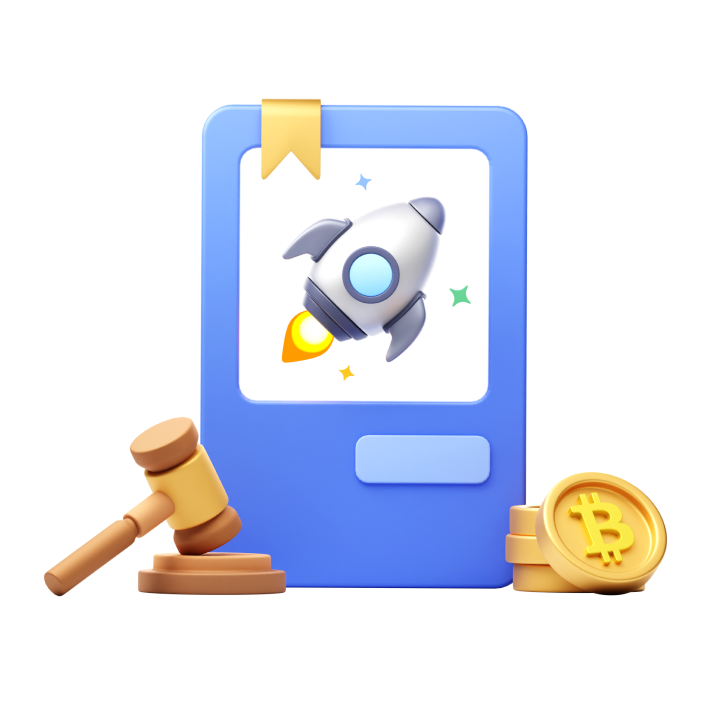
Sayan Chakraborty